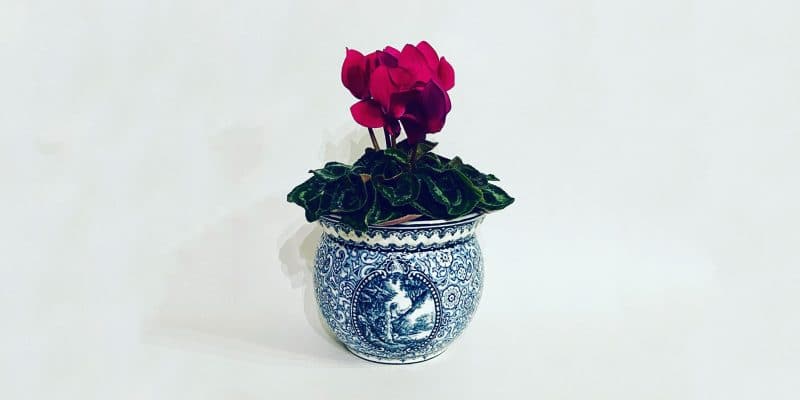Cyclamen is one of those rare houseplants that’s appreciated for its flowers almost more than its foliage. In fact, Cyclamen flowers come in an array of eye-popping colors and have petals that bend backwards (whoa!).
Cyclamen does have a few tricky care requirements that we’ll get into, especially regarding dormancy, but it’s by no means a diva.
We’ll teach you everything you need to know about Cyclamen care, from its mini variety, to getting it to bloom, to keeping it flourishing year-round!
Table of Contents
Cyclamen Plant Care Guide
History, Habitat, and Characteristics
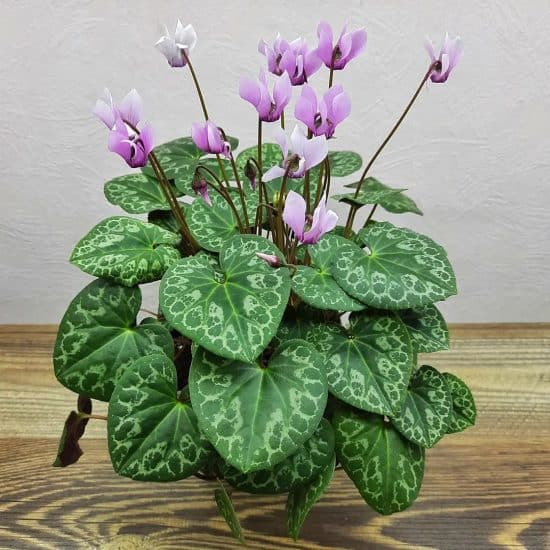
Naturally found from Algeria to the eastern Mediterranean, Cyclamen (Cyclamen persicum) boasts a rich history of cultivation, dating back to 4000 BC. Ancient Greeks and Romans cultivated Cyclamen for ornamental purposes and even used it for medicinal treatments, from inflammation to snake bites.
There’s no question that Cyclamen is still well-loved today. The version you see sold in stores, called the Florist’s Cyclamen, is actually a cultivar of the wild variety. It’s especially popular for Valentine’s Day and the Christmas holiday season because of its heart-shaped leaves.
This perennial plant has captured many hearts with its unique, butterfly-like flowers and silvery, lacy designs atop dark green leaves.
A member of the Primulaceae family, the Cyclamen species shares some features with its botanical cousins, such as clusters of leaves around the base of the plant and stems that shoot up with flowers.
However, this plant has a few tricks up its sleeve to stand out from the crowd. Its petals are bent backwards, and the flowers come in a variety of colors, including white, pink, purple, and red. Its beautifully marbled leaves also make it appealing to the eye.
Fun fact: Proper care for Cyclamen means this adaptable plant can thrive for an impressive 20 to 30 years. Talk about a long-lasting relationship!
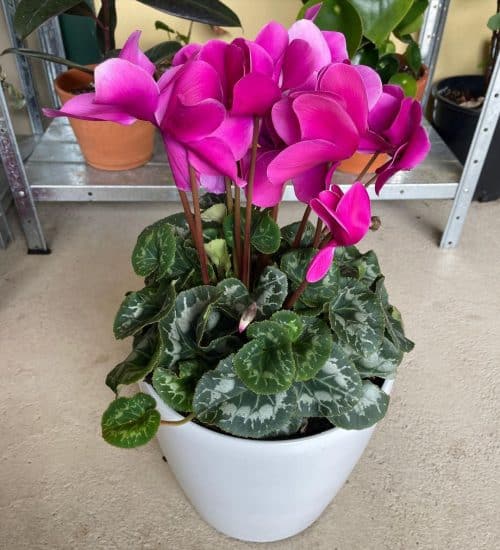
There are over 20 species of Cyclamen, including Cyclamen purpurascens, which is a variegated version with white and purple heart-shaped leaves. It’s known as the most hardy Cyclamen of them all, and has super fragrant pink blooms.
There’s also a smaller version called Mini Cyclamen that looks the same as the Florist’s Cyclamen, but only grows up to 4 inches tall and wide. How cute!
Light
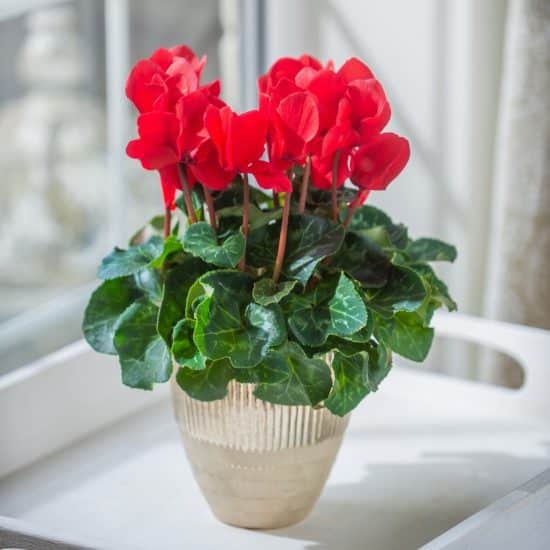
Cyclamen plants crave lots of light, but direct sun can overwhelm them. The perfect spot for a potted Cyclamen, particularly during the growing period in the cooler part of the year, is near a sunny window that gets bright, indirect light.
Keep an eye out for slow, leggy growth, and yellowing leaves, which may indicate your Cyclamen isn’t getting enough light.
Conversely, if your plant is getting too much light, you may notice wilting leaves and flowers that fade quickly.
Our lighting tips:
- Growing Cyclamen near a bright, east- or west-facing window is ideal to ensure plenty of indirect light.
- Keep your plant out of direct sunlight to prevent wilting leaves and rapidly fading Cyclamen blooms.
- If your Cyclamen appears starved for light, consider using a grow light (opt for LED to conserve energy) to supplement natural light.
- If you notice your Cyclamen suffering from too much sunlight, add a sheer curtain to the window or move the plant to a slightly shadier location.
Water
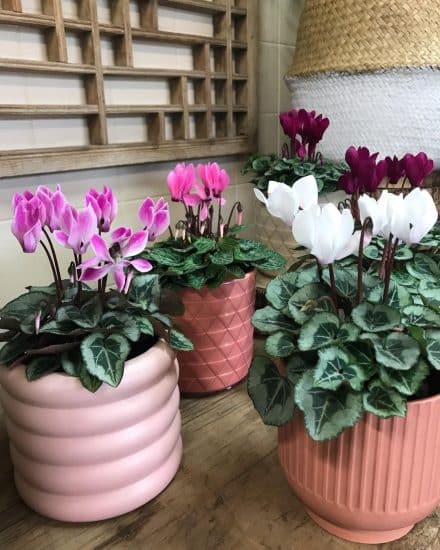
Watering your Cyclamen properly is crucial to its overall health and well-being. A balance between moist and dry conditions is key to helping your indoor Cyclamen thrive.
One sign that your Florist’s Cyclamen is not receiving enough water is the presence of wilting or yellowing leaves. To remedy this, you’ll want water more often, ensuring you don’t let your plant dry out too much between waterings. Remember, a parched Cyclamen isn’t a happy one!
Receiving too much water can also cause wilted or yellowing leaves, similar to those of underwatered plants. However, overwatering can also cause more serious issues like root rot. Make sure you’re allowing your Cyclamen to dry out a bit between waterings to prevent overwatering.
The key here is finding that perfect balance between too much and too little water for your Cyclamen’s unique needs. You may need to experiment a bit with the watering until you find that sweet spot.
Our watering tips:
- Focus on maintaining a balanced moisture level — not too dry, not too soggy — to ensure your Cyclamen stays healthy and hydrated.
- If you notice wilting or yellowing leaves, adjust your watering routine accordingly to provide more water for an underwatered Cyclamen, or less water for an overwatered one.
- Keep tabs on your Cyclamen’s health and respond to any changes you see. Properly adjusting your watering schedule is essential for a thriving plant.
Temperature and Humidity
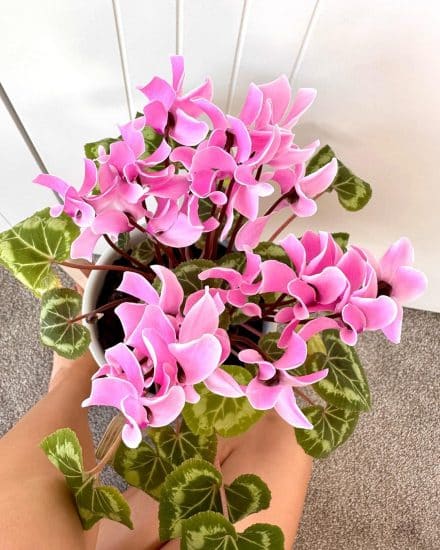
Growing Cyclamen plants require specific temperature and humidity conditions to truly flourish.
Your Cyclamen will be happy in cool temperatures between 50-65°F (10-18°C). It will likely appreciate the coolest room in your house. Be sure to avoid placing it near heat sources like fireplaces or furnaces.
If your Cyclamen is subjected to unsuitable temperatures, it could experience wilted or yellowing leaves, and a decrease in flowers.
Temperatures that are too low may result in stunted growth and delayed flowering, whereas high temperatures can lead to a leggy plant and a loss of flowers.
Cyclamen likes humidity between 40-60%. Excessive humidity might cause the plant to rot, while too little humidity can make the leaves drop or curl, and flower buds wither. Keep an eye out for these signs, as they indicate that it’s time to adjust the humidity levels around your plant.
Soil and Planting
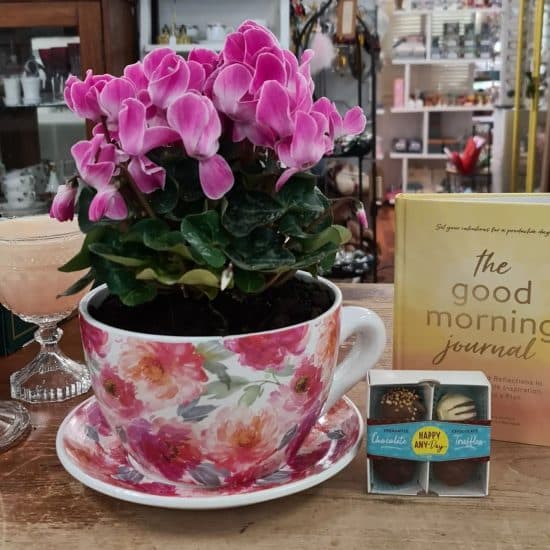
Cyclamen thrives in well-draining, slightly acidic soil that offers a perfect balance of moisture and aeration.
A nutrient-rich soil mix with a blend of peat-free compost with added perlite or grit is the way to go for Florist’s Cyclamen. It offers good drainage and ensures that the roots have access to oxygen, while also retaining moisture to ensure the long-lasting health of your plant.
Timing is everything when it comes to transplanting your Cyclamen. The best time is during its dormancy (which occurs after it finishes flowering, typically around early spring).
This will allow your plant to adjust to its new environment without putting energy into flowering, promoting a smooth transition and encouraging new growth in the following season.
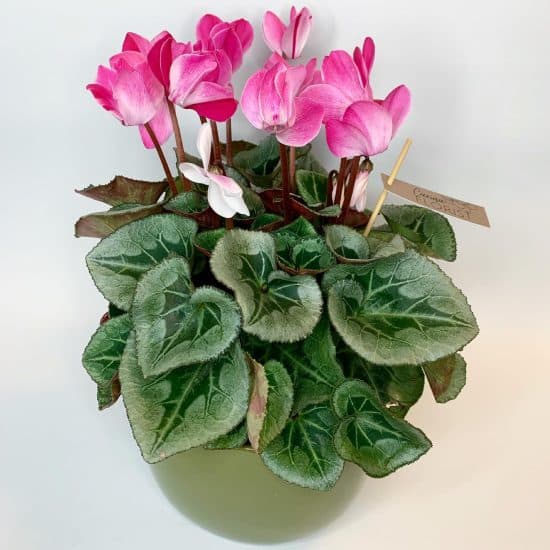
Fertilizer
Feeding your Cyclamen is vital to its growth and production of beautiful flowers. Apply a general-purpose fertilizer during the active growing season to provide the nutrients it needs.
Keep an eye out for signs of over-fertilization though, such as yellowing or wilting leaves (especially if you’ve ensured your Florist’s Cyclamen plant is being properly watered and maintained at its ideal temperature).
If you suspect over-fertilization, simply flush excess fertilizer from the soil by pouring water through it for several minutes. Make sure to let the water drain out of the pot completely to avoid root rot.
Propagation
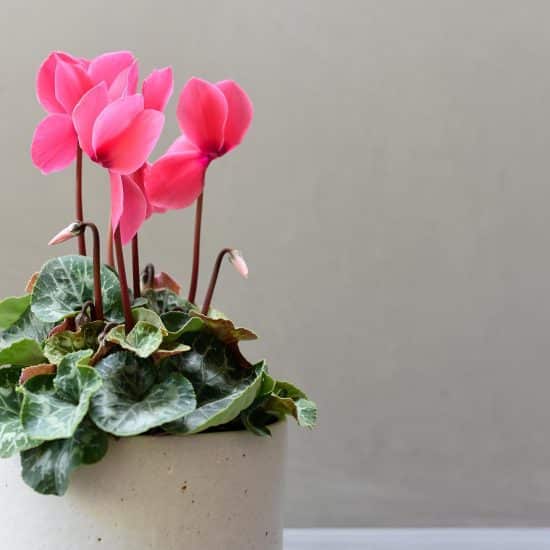
Expanding your Cyclamen collection is as easy as dividing the offsets that appear from the main tuber (a thick underground stem that stores energy for the plant, enabling it to survive dormancy each year).
Propagation via division of offsets:
- Wait for the right moment: Indoor Cyclamen plants enter a dormancy period after their flowers fade. During this time, their foliage will begin to yellow and die back. This dormancy period is a perfect time for propagation, as it lets the plant focus its energy on new growth, rather than maintaining existing foliage and flowering.
- Gently free the plant from its pot: Carefully remove your Cyclamen from its pot by grasping the plant’s base and cautiously loosening the soil around the edges of the pot. Once the plant is liberated from its pot, gently brush off excess soil from the roots and tuber.
- Examine the tuber and separate: Check the main tuber for small offsets growing around it. With a sharp sterilized knife or gardening shears, cut the offsets away from the main tuber. Ensure each offset has a portion of roots attached to it for the best chances of success.
- Give the offsets a new home: Fill new pots with a well-draining potting mix. Plant each offset into its new pot, positioning the tuber so that the top is just below the soil surface. Water the soil lightly to help settle it around the tuber.
- Nurture the new plants: Place the newly potted offsets in a bright spot that receives indirect light. Keep the soil lightly moist but not waterlogged, and provide consistent temperatures between 50-65°F (10-18°C) for optimal growth. Be patient, as new growth may take a few weeks to appear.
Our propagation tips:
- Keep it clean: Before starting the propagation process, ensure that your hands and work surface are clean, and that any tools you use to cut are sterilized to avoid introducing infections.
- Embrace the cool: Cyclamen plants prefer a slightly cooler environment than many other houseplants. Place your offsets in a cooler area of your home, away from heat sources.
Common Issues
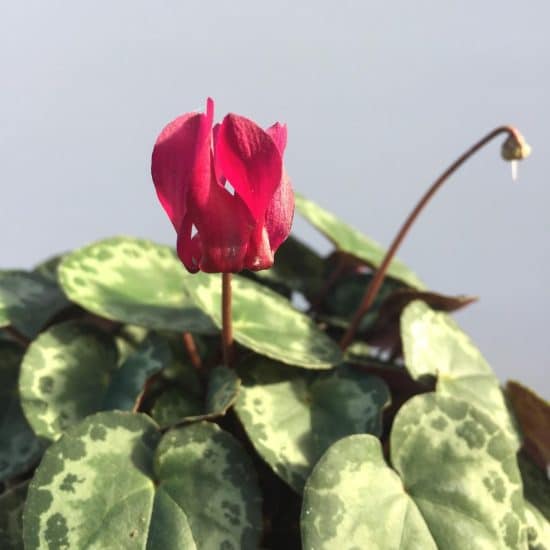
Cyclamen plant care means sometimes dealing with issues like yellow leaves, but we’re here to help diagnose and solve the problem.
Yellowing Leaves
This is often due to overwatering or inadequate drainage. To pinpoint the problem, check if the leaves are turning yellow and feel mushy or limp.
If so, get your plant back on track by allowing the soil to dry out between waterings, and double-check that your pot has proper drainage holes.
By adjusting your watering routine, you’ll help prevent yellow leaves from returning in the future. If needed, give your Cyclamen a fresh start by repotting it into new soil with better drainage.
Summer Dormancy
Cyclamen needs a little downtime during the warmest part of the year — think of it as a well-deserved break. While this isn’t a problem, it is something to keep an eye out for.
You might observe the leaves turning yellow and the plant seeming to wilt, but don’t panic! Just reduce watering and store the plant in a cool, dry, and dark place.
Once summer passes, it’s time to gently wake your plant from its slumber: gradually reintroduce light and increase watering to encourage new growth.
Pests and Diseases
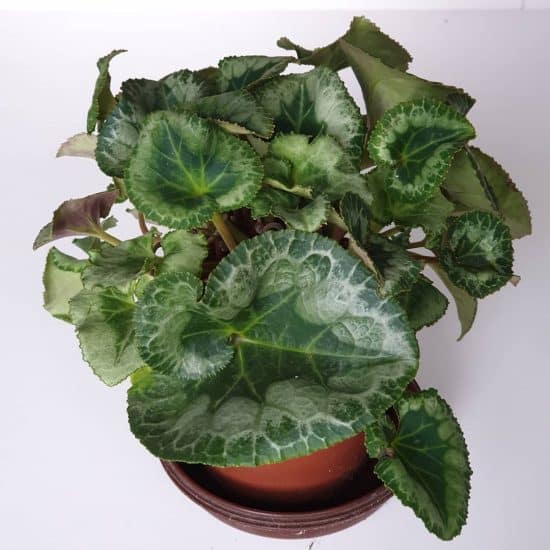
Cyclamens are typically tough plants, but may sometimes need help fighting off common pests and diseases.
Pests
If they find their way to your Cyclamen, sap-sucking pests, slugs, snails, and spider mites can cause puckered leaves, fewer flowers, and hindered growth. Slugs and snails may otherwise distort the plant’s appearance, and commonly leave tiny trails behind.
If you need to deal with these uninvited guests, consider using a commercially available insecticide or sulfur hotbox. Be careful here, though, since certain treatments can cause mutations to your plant’s flowers during the season. Always follow the label instructions to ensure you’re applying the treatment correctly.
Crown Rot
Crown rot, a fungal disease, can affect your indoor Cyclamen plant. This issue often arises from overwatering or poor drainage, leading to decaying plant tissue. To spot crown rot, look for yellowing leaves or blackened, mushy stems near the plant’s base.
To tackle crown rot, remove the affected plant parts and repot your Cyclamen in fresh, well-draining soil. If you’re reusing the same pot, sterilize it before replanting. Ensure that any pot you use has drainage holes.
Prevent this issue from happening again in the future by letting your plant dry out a bit more between waterings, and by placing it in a well-ventilated area with good airflow.
Conclusion
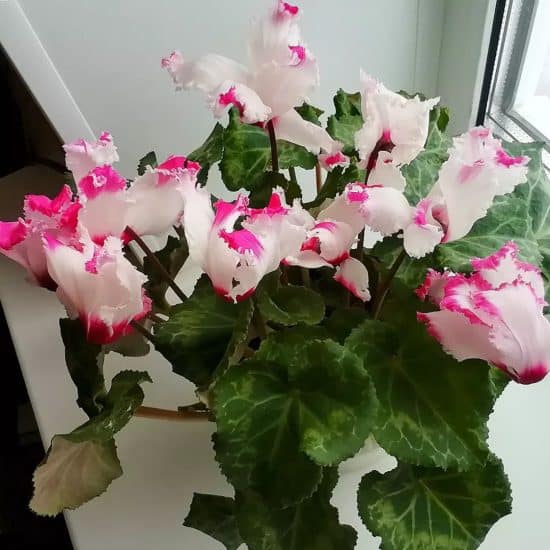
That’s it for our Cyclamen care guide! You’re now equipped with the knowledge and tips needed to grow and maintain a gorgeous, vibrant Cyclamen in your indoor garden.
Cyclamen care summary:
- Cyclamen plants prefer a cool environment with temperatures between 50-65°F (10-18°C).
- Provide plenty of indirect light, keeping your plant near a bright east- or west-facing window.
- Maintain a balanced moisture level for your Cyclamen plant, avoiding overwatering and underwatering.
- Use a well-draining soil mix and fertilize during the growing season. If you plan to transplant your Cyclamen, remember to do it while it’s dormant.
- Keep an eye out for any signs of pests or diseases and tackle any issues promptly to keep your Cyclamen in top shape.
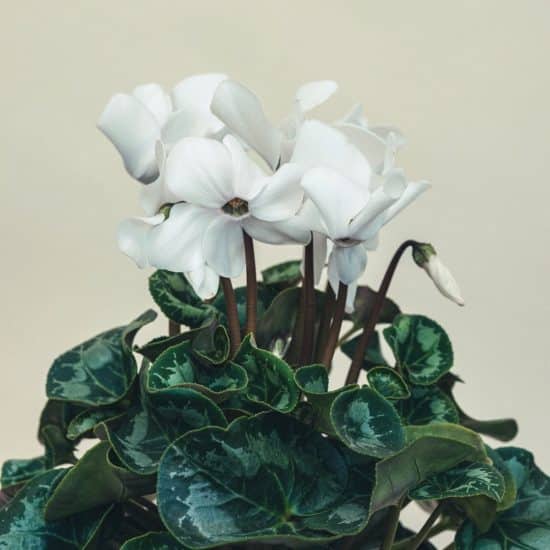
We hope this guide has helped you understand how best to care for Cyclamen plants. If you have any questions or need further guidance, don’t hesitate to reach out to us.
And don’t forget to share your Cyclamen journey with fellow plant lovers, spreading the love for this enchanting houseplant.
Take care, and happy gardening!
FAQ
What are some other common Cyclamen species to grow?
Besides Cyclamen persicum, some of the most popular species to grow include Cyclamen hederifolium, easily identified by its ivy-shaped leaves and delicate pink flowers; and Cyclamen coum, a perfect burst of color for winter gardens, boasting rounder leaves and dainty blooms in shades of pink and magenta.
Other noteworthy Cyclamen varieties that are commercially available include Cyclamen cilicium, Cyclamen graecum, Cyclamen repandum, and Cyclamen purpurascens (the most hardy Cyclamen of the bunch!). Each offers its own delightful display of beauty and elegance.
How can you encourage Cyclamen to bloom?
To coax your Cyclamen into producing an abundance of stunning blossoms, place it in a chilly room (at the bottom end of its ideal temperature range of 50-65°F or 10-18°C).
Water your plant judiciously, avoiding the crown and leaves, and ensure that the soil remains evenly moist but never waterlogged. Cyclamen bloom better if you offer a balanced liquid fertilizer every three to four weeks during the growing season. This will provide your Cyclamen with the nutrients it craves to produce those vibrant, eye-catching flowers.
How does care differ if you keep Cyclamen outside?
If you’re looking to grow Cyclamen outside, first, select a species suitable for outdoor environments (such as Cyclamen hederifolium or Cyclamen coum).
Provide a sheltered spot with well-draining soil, partial shade, and protection from harsh winds. When grown outdoors, Cyclamen also appreciate a layer of organic mulch to help maintain soil moisture and temperature.
It’s important to note that, like their indoor counterparts, outdoor Cyclamen require cool temperatures and balanced humidity for optimal growth and blooming.
Do Cyclamen come back every year?
Cyclamen are known as perennials, meaning they have the ability to come back year after year. The plant enters a period of dormancy, usually during the warmer months, when the leaves die back and the plant seemingly “disappears.”
But it’s not gone! With proper care, your Cyclamen will spring back to life when temperatures cool down, producing fresh foliage and dazzling blooms once more. To ensure a triumphant return, continue to provide water sparingly during dormancy, and keep the tuber in a cool, dry spot until new leaves emerge.
Are Cyclamen indoor or outdoor plants?
Cyclamen are versatile wonders, able to thrive as both indoor and outdoor plants, depending on the species and growing conditions.
Cyclamen persicum is commonly grown indoors, while hardier varieties like Cyclamen hederifolium and Cyclamen coum fare better outside, adding delightful pops of color to gardens, living borders, and outdoor containers.
Whether they’re grown as outdoor or indoor container plants, Cyclamen will enchant you with their unique beauty.

